|
observer |
|
|
|
|
|
OTHER LINKS |

|

|

|
|
Turtles under threatThe golden sandy beaches suddenly turn
into a hive of activity as new life emerges out of the sand... It's
turtle But, how many of those tiny hapless creatures would succeed in pitting their puny strength against the forces and dangers lurking in the mighty waters and survive? Only time would tell, because even their short journey into the sea is under severe threat. Turtles which are classed as reptiles and belong to the order testudines are a highly threatened species. Their chances of survival are slim as they face danger not only from natural enemies such as birds and other marine creatures, but also from man; they are hounded from egg stage to adulthood. So, turtles are hapless creatures that need your protection and care to survive. There are about 300 species of turtles alive today and the majority of them are threatened or highly endangered. Turtles are divided into two groups - Cryptodira which are the turtles that can draw in their neck and fold it under
their spine and Pleurodira that can only fold their neck to the side. Turtles are also divided as marine turtles and freshwater turtles. They vary widely in size. While marine turtles are relatively big animals, freshwater turtles are smaller. A distinctive feature of these reptiles are their shells. Did you know that the inner layer of a turtle's shell is made up of 60 bones including the backbone and ribs? This means that a turtle cannot crawl out of its shell. The leatherback turtles are the only marine turtles whose backbone is not attached to the inner shell. The upper part of a turtle's shell is called the carapace and the lower shell, the part covering the belly area, is known as the plastron. These two parts are joined by bony structures called ridges. Carapaces are in the shape of domes and could be high domed or low domed. In most turtles, the outer layer of the shell is covered by horny scales called scutes. It is part of its outer skin. Scutes are made of fibrous protein called keratin. The shape of the shell gives clues to how they live. The dome-shaped
shells are a form of protection because You may have seen what a tortoise's shell looks like, but though turtle shells look similar, they are not as heavy. As turtles live mostly in water and need to get around fast, their shells are much lighter than those of tortoises. This prevents sinking and helps them to swim with more agility. The colour of their shells could vary from brown to black or olive green. In some species, the shells have red to orange or yellow or grey markings in the shape of lines, spots or irregular blotches.
Most turtles have eyes placed on the upper side of their heads, but some aquatic turtles like the snapping turtles and soft-shelled ones have eyes closer to the top of the head. Sea turtles possess glands near their eyes that produce salty tears. This helps them to rid their bodies of the excess salt taken from the sea water they drink. This 'shedding of tears' done by female turtles that come to the shore to rest, is mistaken by some as 'crying' when laying eggs. Turtles are believed to have exceptional night vision though their daytime vision is marginal due to colour blindness. Amphibian turtles have feet similar to tortoises, but they are webbed
and often have long claws, especially the males. They swim using all
four limbs, similar to the dog paddle. The large sea turtles swim less
than the smaller The diet of turtles varies with the species. Some turtles may be carnivorous, some herbivorous and others omnivorous. The jaw indicates the diet. Depending on the species, the diet could include sponges, molluscs, crabs, sea urchins, sea weed, worms, slugs, raspberries and mushrooms (that are usually poisonous to people), snails, insects, crayfish and clam.
Even tadpoles, small frogs, fish and spiders are food for turtles. Turtles can use their tongue to swallow food, but unlike most other reptiles, they cannot stick out their tongues to catch their food. Find out more about these tortoise-like reptiles and do whatever you can to help protect them, their habitats, nesting grounds and their hatchlings.
**** Fact file* Leather back sea turtles and soft-shelled turtles have leathery skin-covered shells. * Turtles are killed for their meat and shells. Their eggs are stolen for food. * Marine turtles are an indicator as to how our oceans are doing. * Green sea turtles are the largest hard-shelled sea turtles. * Adult male turtles have longer, thicker tails which may extend beyond their hind flippers. * Like in other reptiles, sea turtles have a single bone in the middle ear that conducts vibrations to the inner ear. * They can see well under water, but are short-sighted in the air when they are out. * There are eight recognised species of sea turtles: Green turtles, Black turtles, Loggerhead turtles, Kemp Ridley's turtles, Olive Ridley turtles, Hawksbill turtles, Flatback turtles and Leatherback turtles. * Land turtles can retract limbs under their shells, but most other turtles have non-retractable heads and limbs. * Sea turtles have long upper eyelids that provide protection for eyes, but they do not have external ear openings. They also lack teeth. ***** Let's protect our own turtles!The marine turtles in Sri Lanka too are under severe threat of extinction and the Department of Wildlife
Conservation has taken measures to protect this species. As a result, all sea turtles and their products are fully protected under the Fauna and Flora Protection Ordinance. So, if you come across any products, especially ornaments turned out of turtle shells, don't purchase them. Not only the turtles, but even their eggs are not spared by people who collect them to sell to hatcheries and also as food because turtles' eggs are considered a delicacy by many. It is said that almost all the eggs laid along the south west coast of Sri Lanka are collected by the people in the area.
Yala and Induruwa are popular for Green Turtle, Olive Ridley and Leatherback Turtle nestings. There are many other areas where turtle nestings have been recorded such as Akurella and Ambalantota. Turtles are a part of our environment and they contribute to our life
cycle like all other animals. Lack of awareness Marine pollution too adds to this problem, so take time to learn about these harmless and gentle creatures that come to our beaches to lay their eggs, to help save and protect them. |

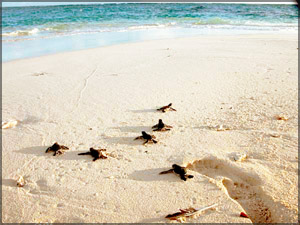 egg hatching time! Hundreds of cute, baby turtles could be seen crawling
with great difficulty, to their future home; the vast, unpredictable
ocean.
egg hatching time! Hundreds of cute, baby turtles could be seen crawling
with great difficulty, to their future home; the vast, unpredictable
ocean. 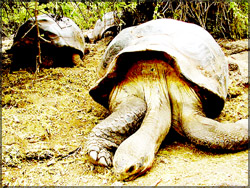
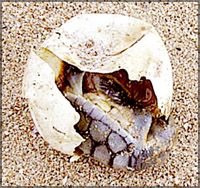 predators find it difficult to crush.
predators find it difficult to crush. 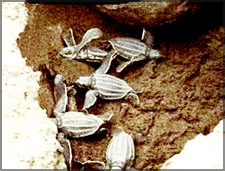 As
turtles are reptiles and most reptiles shed their skin, which is known
as 'moulting', you may be curious to know if turtles too shed their
skin. The answer is yes, but turtles do not moult in one go like snakes
do. They shed their skin continuously, in small pieces.
As
turtles are reptiles and most reptiles shed their skin, which is known
as 'moulting', you may be curious to know if turtles too shed their
skin. The answer is yes, but turtles do not moult in one go like snakes
do. They shed their skin continuously, in small pieces. 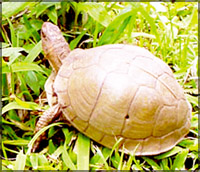 species. Sea turtles are entirely acquatic and instead of feet, they
have flippers. They could be seen 'flying' through the water, using the
up-down motion of front flippers. Back feet are used as rudders for
steering. Compared to freshwater turtles, sea turtles have very little
mobility on land. In fact, apart from the dash from nest to the sea as
hatchlings, male sea turtles never come to land. Females get to the
shore for nesting by dragging themselves with their flippers.
species. Sea turtles are entirely acquatic and instead of feet, they
have flippers. They could be seen 'flying' through the water, using the
up-down motion of front flippers. Back feet are used as rudders for
steering. Compared to freshwater turtles, sea turtles have very little
mobility on land. In fact, apart from the dash from nest to the sea as
hatchlings, male sea turtles never come to land. Females get to the
shore for nesting by dragging themselves with their flippers. 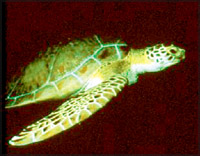
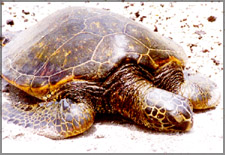
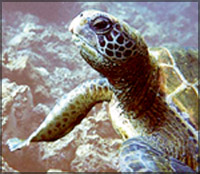 Most
often, it is the female sea turtles that are at risk of being killed
because they are highly vulnerable when they emerge from the sea to lay
their eggs on land. Hawksbills turtles nest most in areas such as
Kosgoda, and Bundala. Kosgoda is also popular for Green turtle, Olive
Ridley Turtle, Leatherback Turtle and Loggerhead Turtle.
Most
often, it is the female sea turtles that are at risk of being killed
because they are highly vulnerable when they emerge from the sea to lay
their eggs on land. Hawksbills turtles nest most in areas such as
Kosgoda, and Bundala. Kosgoda is also popular for Green turtle, Olive
Ridley Turtle, Leatherback Turtle and Loggerhead Turtle. 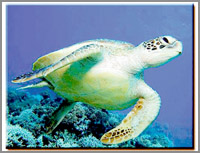 about the biology and conservation value of these creatures has led to
their destruction and exploitation.
about the biology and conservation value of these creatures has led to
their destruction and exploitation. 






